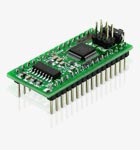 |
NanoCore12 is a low-cost platform that brings the advanced features of the 9S12C microcontroller family within easy reach of engineers, students, and hobbyists. The flexible design accommodates all facets of training, evaluation, development, prototyping-- and even volume production.
While there are several DIP-format MCU modules on the market, none of them comes close to the power and value of NanoCore12! Others are based on RISC processors-- some relying on serial program memory, and have limited or no hardware subsystems on-chip. NanoCore12 is the only complete family of DIP modules based on a high-speed CISC device. Since RISC processors only possess primitive instructions, their high speed is necessary, in order to produce acceptable computing power. With a CISC processor running at the same speed, the overall performance is vastly improved-- and performance improvement is in orders of magnitude for certain types of operations. The HCS12 instruction set includes powerful DSP-like instructions, 16-bit arithmetic, and the architecture implements memory-to-memory moves, and many powerful addressing modes. These features are way beyond what any PIC, AVR, or 8051 processor offers today.
- based on the 9S12C32 MCU (48-pin LQFP version)
- includes 8 Mhz crystal
- 24 MHz bus speed (via PLL)
- local 5 Volt low-dropout 100 mA regulator
- includes RS232 transceiver circuit
- has on-chip Serial Monitor
- supports standalone operation
- 32K Bytes Flash
- 2K Bytes Ram
- offered in 24-pin, 32-pin, or 40-pin DIP form-factor
- low-cost gold-plated square pins
- pinout is super-set of competing 24-pin modules on the market
- the 32-pin NC12DXC32 is functionally equivalent to Freescale part #M68MOD912C32
Product Details
Ease-of-Use Features:
- supports programming in C, BASIC, Forth, assembler, etc.
- no special Flash programming voltage or switch required
- fast in-circuit programming
- small footprint on-chip bootloader/monitor and free uBug12 GUI for quick loading/debugging of user programs on a Windows platform
- Run/Load switch for choice of Standalone or Monitor operation following reset
- compatible with virtually all 9S12 development tools on the market
Flash-based code development using on-chip debug/monitor
With a 2K Flash-resident debug/monitor program, you'll be able to load your program into the remaining Flash via the serial port using the CodeWarrior or uBug12 user interface for Windows. The entire Flash can be programmed in seconds! To use the monitor for debugging or code-loading, just set the switch to LOAD. To run your standalone program thereafter, leave the switch at RUN. Your code runs from Flash, and interrupts are supported (via Flash-based pseudo vectors, since the monitor resides in the vector space of the MCU). A program you load into Flash this way will run every time you apply power or reset the board in Run Mode.Flash-based code development using a BDM pod
If you want to take advantage of a more advanced development tool (such as MicroBDM12LX), the entire Flash can be used, because the Flash-resident bootloader is no longer needed (therefore pseudo-vectors aren't required either). You'll also need to use this method if you are using a non-Windows development platform.Detailed Features:
- implements PLL loop filter circuit, supporting up to 48MHz operation (24 MHz bus speed)
- standard 6-pin BDM connector for full debugging capabilities (with an optional BDM pod)
- ECLK signal is user-accessible (via pad on circuit board)
- pinout is superset of BASICStamp2®
- access to eight 10-bit analog input or digital I/O port lines (Port AD)
- access to eight digital I/O port lines (Port T)
- up to five PWM timer channels (PT0 - PT4)
- up to eight Input Capture/Output Compare pins (Port T)
- serial peripheral interface (SPI)
- serial communications interface (SCI)
- controller area network (CAN 2.0) (logic-level pins brought out on 32-pin and 40-pin versions; 40-pin also has CAN transceivers)
- internal programmable pullup and pulldown resistors on most pins
- user access to MCU reset signal
- gold-plated 0.025" square pins plug into standard dual-leaf DIP sockets and solderless breadboard
Resources
Data:
Tools:
- Pluto Visual Debugger
- uBug12 GUI for working with the on-chip Serial Monitor under Windows and .NET framework (if you need it)
- Linux command line tool hc12mem for working with the Serial Monitor
- SynCode: Free Integrated Editor and GNU C Compiler package for Windows
- Demo C compiler from Metrowerks. It now has a 32K limit, so it's essentially free for NanoCore12C32 users !
- 45-day Demo C compiler from ImageCraft
- Windows IDE for GNU C
- Using the GNU Development Tools for 68HC11 and 68HC12
- 68HC11/HCS12 Application Notes for ICC and GNU C Compilers
- FreeRTOS for 9S12C32
- Karl Lunt's binload utility

